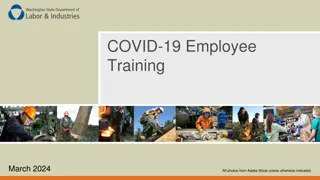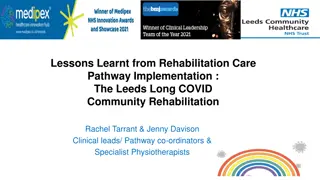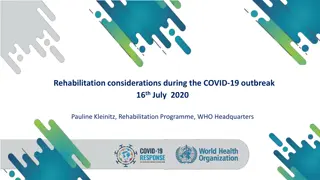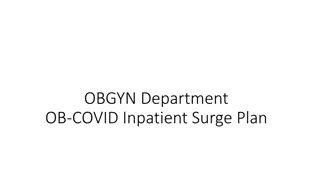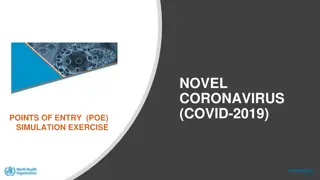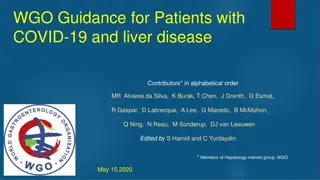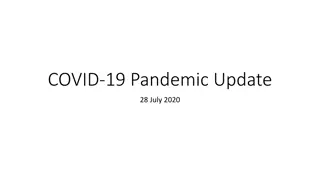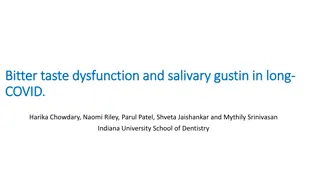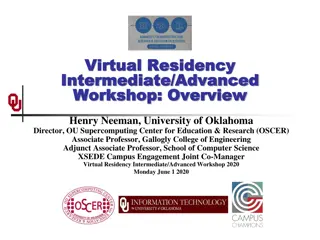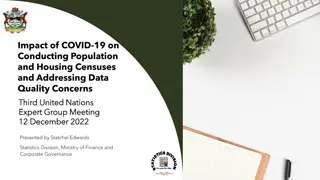Covid-19 Situation Overview and Definitions Workshop
This workshop addresses the current Covid-19 situation, basic concepts, roles, responsibilities, testing, and more. It includes insights on deaths, hospital admissions, confirmed cases, and definitions related to Covid-19. Explore the essential information presented in the workshop.
Download Presentation

Please find below an Image/Link to download the presentation.
The content on the website is provided AS IS for your information and personal use only. It may not be sold, licensed, or shared on other websites without obtaining consent from the author.If you encounter any issues during the download, it is possible that the publisher has removed the file from their server.
You are allowed to download the files provided on this website for personal or commercial use, subject to the condition that they are used lawfully. All files are the property of their respective owners.
The content on the website is provided AS IS for your information and personal use only. It may not be sold, licensed, or shared on other websites without obtaining consent from the author.
E N D
Presentation Transcript
Cambridgeshire.gov.uk Residential provisions for Children in Care and / or with an EHCP: Covid-19 Workshop 21 January 2021 1 Peterborough.gov.uk
Housekeeping Please ensure that you are on mute when not speaking Questions please use chat function to submit questions Please be patient with us! Cambridgeshire.gov.uk Peterborough.gov.uk 2
Welcome Children s Commissioning Helene Carr Head of Service, Children s Commissioning Lucy Loia Senior Commissioning Manager, SEND Anita Hewson, Commissioning Manager, SEND Sam Nash Commissioning Manager, CiC Public Health Dr Rajalakshmi (Raj) Lakshman Consultant in Public Health Medicine Yasmin Akhtar Health Protection Practitioner Cambridgeshire.gov.uk Peterborough.gov.uk 3
Agenda 1. Overview of current Covid Situation Across PCC, CCC & nationally 2. Some basic concepts and terms 3. Roles and responsibilities 4. What to do if you have a suspected case/positive case in your setting 5. Testing and Vaccines 6. Information Sharing 7. FAQs
1. Overview of the current Covid-19 Situation across PCC, CCC and Nationally
Numbers of deaths and patients admitted to hospital are still increasing though numbers testing positive have decreased substantially in recent days. C&P Source: Coronavirus.gov.uk 20 January OFFICIAL
2. Some basic concepts about Covid-19 and definitions we use
Definitions Used During the Covid-19 Pandemic Possible or suspected (symptomatic) case: Anyone with a new continuous cough and/or high temperature and/or a loss of, or change in, normal sense of taste or smell (anosmia) Confirmed case: Anyone with a laboratory test positive for COVID-19/SARS-CoV-2 with or without symptoms Exposure: A single confirmed case Cluster: Two or more unlinked confirmed cases of COVID-19 Outbreak: Two or more confirmed cases of COVID-19 who are direct close contacts, proximity contacts or in the same cohort or bubble in the care home within 14 days. Contacts: A person who has been close to someone who has tested positive for COVID-19 during the infectious period: had face-to-face contact of any duration (less than 1 metre away); or were coughed or sneezed on; or spent more than 15 minutes within 2 metres of each other; or travelled in a car or other small vehicle (even on a short journey) From 48 hours prior to symptom onset to 10 days after, or 48hrs prior to test if asymptomatic Contact tracing starts as soon as there is a confirmed case. Contacts and cases need to isolate for 10 days- this is a legal requirement Infectious Period:
New highly transmissible variant: Control measures Previously identified measures will work but are likely to require a step change in rigour of application Control measures to reduce transmission through all routes; close-range, airborne, and via surfaces Reducing social contacts and maintaining 2 mts distance High adherence to testing and self-isolation of cases and contacts Consistent use of high-quality face-coverings whenever indoor close contact mixing is unavoidable https://www.cam.ac.uk/coronavirus/stay-safe-cambridge- uni/wear-a-face-covering Ventilation of enclosed spaces Appropriate Cleaning (see slides 33 35) Protecting the vulnerable (older people, shielding)
Public Health England and Local Authority Responsibilities Local Authority PHE The Local Authority Public Health will: PHE Health Protection Team (HPT) will: Organize an Incident Management Team meeting where needed Will collect and organize ongoing information and risk assessments if needed Will organise any testing in the home, if required Will support the home to implement control measures Will continue to provide ongoing advice and support the children s home or LA cell for managing the outbreak, as needed Collect information and undertake an initial risk assessment (once notified of a new case) Will discuss general infection control arrangements Will inform the LA SPOC (i.e. CCC & PCC Public Health) of the information they have acquired and advice given In cases which an IMT is required, PHE and LA will jointly hold an IMT where PHE will provide health protection advice and support
IMT (Incident Management Team) IMT Request Form An IMT is a multi-disciplinary, multi-agency group with responsibility for investigating and managing the incident The purpose of the meeting is to evaluate the current situation, ensure that appropriate mitigation measures have been put in place and to review the need for any further support from one of the partners around the table Requesting Organisation What is an IMT? Name and Address of outbreak setting It enables a multi-disciplinary approach to the management of the outbreak It provides for a review of the incident, plans to mitigate the outbreak and the impact of those plans It allows coordination of action to determine the need for escalation It decides when the outbreak is over Postcode: Name: Phone: Email: Contact Name and details What does an IMT do? HP Zone No. (if available) Date and Time of the IMT Increasing numbers of cases despite control measures What control measures to implement Lack of clarity as to whether it s a cluster, an outbreak or more than one outbreak Inconsistent information from several different sources First outbreak in the setting Media interest Is this a new outbreak/situation? What kind of things can an IMT help with? Brief description of the outbreak/situation What specific input is required from the HPT? Anyone involved in the incident! Fill out the IMT Request Form and send to AdminC19.Team@cambridgeshire.gov.uk and C19Incident.Cell@cambridgeshire.gov.uk with CC to Kai- Nneka.Townsend@cambridgeshire.gov.uk; kate.Parker@cambridgeshire.gov.uk Who can request an IMT?
Pre-IMT checklist Gather details of Outbreak- staff, children and young people, lay-out of home Ensure all symptomatic staff are excluded from the workplace for at least 10 days and until they are well, with no fever. Have a low threshold for identifying symptoms Ensure all close contacts are been identified and asked to isolate. Use definition of workplace contacts to help identify close contacts of the case(s), considering: shared workspaces; meeting areas; communal areas such as break rooms, changing rooms, kitchens, smoking shelters, bus stops; shared transport For each close workplace contact, determine why the close contact occurred. Where possible, implement measures to prevent those contacts in future Check for any obvious links between the cases. E.g. same shift or team/same work department or area/car sharing/house sharing/socialising Check, reiterate and reinforce all COVID-secure measures, incl. handwashing, cleaning, social distancing, mask wearing, ventilation of enclosed spaces, home-working/minimal occupancy Consider an audit of compliance with prevention measures, including checks on communal areas, inside and outside of the workplace (e.g. bus stops, smoking shelters) Set up regular communication with remaining staff about the situation, including situational updates and reminders around: symptoms to look out for; who/how to alert; isolation measures needed; how to access financial/wellbeing support. Make sure all information, briefings, other communications are in languages spoken by staff Ensure external agencies/contractors are aware of the outbreak e.g. cleaning companies, staffing agencies Remind staff of the need to continue hygiene measures and social distancing outside the workplace, including on transport, at home/in accommodation, and when socialising
4. What to do if you have a suspected/positive case in your setting
Who to inform if there is a Confirmed Case: If you have a confirmed case inform: Public Health England (PHE) email: eoe.crc@phe.gov.uk or 0300 303 8537 and Local Authority Public Health (C19Incident.Cell@cambridgeshire.gov.uk) and Children s commissioning Team (via Covid Incident Alert form - https://cambridgeshireinsight.org.uk/children-and-young-people/childrens-commissioning/ ) *If you can do the contact tracing from the workers diary and alert them that they have been identified as a close contact, then it will speed up the process and the contacts can start self- isolation. See slide 9 for the definition of a contact
What happens next.. Once you have notified Children s Commissioning via the Incident Alert Form Commissioning Manager / Officer will contact you We will confirm with you that PHE and your local Public Health Team have been notified, as well as any relevant professionals We will discuss with you any risk to your service delivery and business continuity We will work with you to explore any contingency plans We will discuss the impact on children, young people and your staff We will agree with you any next steps and follow up discussions
5a. Testing: Rapid (Lateral Flow Tests) & Laboratory (PCR Tests)
Covid-19: Antigen Testing Antigen Testing PCR Gold Standard but takes time and lab capacity Lateral flow testing Not as good as PCR but quicker, cheaper Nose/throat swab Snap shot of whether or not you currently have the virus
Lateral Flow Tests: Pros and Cons Pros: Accessible and easy to use (minimal training needed to operate) No lab required, with fast results (within 30 minutes) Safe technology (nose and throat swab, and is good at detecting cases with a high viral load who are more likely to spread the infection) Cons: False negatives (missed cases) can be upto 50%: better at picking up cases when a person has higher viral load, hence the need to test frequently False positives (those who are not actually positive) ~0.4%: which is why a confirmatory PCR test is needed for LFT positive test results Test performs better when done by skilled/trained people
Some Common Questions About LFT What if a child tests positive on an LFT? Current guidance is that they need to do a definitive Covid-19 PCR test. This may change Contact tracing starts with a positive LFT Do not test the child with a LFT again for 90 days as it is likely to come back with a false positive What if the child is symptomatic but the LFT is negative? Administer a PCR test to the child as soon as possible if they are symptomatic. They will need to continue isolating until the PCR test comes back negative or they have self-isolated for 10 days What if a member of a child s house test s positive but the child has a negative LFT? The child needs to self-isolate until for 10 days even if the LFT is negative
Questions? Cambridgeshire.gov.uk Peterborough.gov.uk 23
Covid-19 Vaccine Prioritisation Phase 1 priority- Prevent most deaths- most vulnerable & those who care for them 1. residents in a care home for older adults and their carers 2. all those 80 years of age and over and frontline health and social care workers 3. all those 75 years of age and over 4. all those 70 years of age and over and clinically extremely vulnerable individuals 5. all those 65 years of age and over 6. all individuals aged 16 years to 64 years with underlying health conditions which put them at higher risk of serious disease and mortality 7. all those 60 years of age and over 8. all those 55 years of age and over 9. all those 50 years of age and over
Covid-19 Vaccine Prioritisation VACCINATION REGISTRATION PROCESS Cambridgeshire and Peterborough CCG will soon be opening new frontline health and social care staff booking slots for COVID-19 vaccinations at Primary Care Network sites across Cambridgeshire and Peterborough between the dates of 18 and 24 January 2021. Cambridgeshire County Council and Peterborough City Council are supporting the roll out of the Pfizer-BioNTech Covid- 19 vaccination programme to frontline social care staff and the following service areas have been identified as priority groups. Residential Children s Homes Independent Special Education Provisions Supported Accommodation Supported Living Foster Carers Activity services for children with complex needs and disabilities Overnight short breaks and shared care Appropriate Adult services Domiciliary Care Direct Payment Support Workers Your organisation will have been contacted with details for the vaccination registration process. Please contact Childrenscommissioningteam@cambridgeshire.gov.uk with any queries.
Covid-19 Vaccine what does this mean for staff? The Joint Committee on Vaccinations and Immunisation (JCVI) state for Clinically Extremely Vulnerable (CEV) people following vaccination Many individuals who are clinically extremely vulnerable will have some degree of immunosuppression or be immunocompromised and may not respond as well to the vaccine. Therefore, those who are clinically extremely vulnerable should continue to follow government advice on reducing their risk of infection. And the government guidance says: Like all medicines, no vaccine is completely effective, so you should continue to take recommended precautions to avoid infection. Some people may still get COVID-19 despite having a vaccination, but this should be less severe. The guidance isn t explicit as to whether reducing their risk of infection means continuing complete shielding for people who are CEV. However, it does appear that, until the guidance changes or is more explicit, CEV individuals should not go back to work in-person (whether they ve had 1 or 2 doses).
Covid-19 Vaccine In Children Current evidence strongly indicates that the single greatest risk of mortality from COVID-19 is increasing age and that the risk increases exponentially with age Following infection, almost all children will have asymptomatic infection or mild disease. There is very limited data on vaccination in adolescents, with no data on vaccination in younger children, at this time. The JCVI currently advises that only those children at very high risk of exposure and serious outcomes, such as older children with severe neuro-disabilities that require residential care, should be offered vaccination. At this time, children are low priority and there is no mass vaccination planned. However, the pandemic is continually evolving and there may be new guidance at some point. Green Book Govt info on vaccines
Covid-19 Vaccine You can find out more about the local programme, including the current vaccination locations, the priority groups for vaccination and more, here: https://www.cambridgeshireandpeterboroughccg.nhs.uk/news-and-events/latest- news/covid-19-national-vaccination-programme/ This page is updated regularly.
https://cambridgeshireinsight.org.uk/children-and- young-people/childrens-commissioning/
General Principles of Cleaning During the Covid-19 Pandemic No symptomatic people or with active Covid-19 Infection Increase the frequency of cleaning, using standard cleaning products such as detergents and bleach Pay attention to all surfaces but especially ones that are touched frequently (i.e. door handles, light switches, work surfaces, remote controls and electronic devices) Aim to wipe down frequently used surfaces a minimum of twice a day (with one of these times at either the beginning or end of day) If there are a lot of people using the space, cleaning should be more frequent Cleaning frequently touched objects in communal bathrooms and kitchens should be prioritised Ensure suitable hand washing facilities are available including running water, liquid soap and paper towels or hand driers. Where cloth towels are used, these should be for individual use and laundered in accordance with washing instructions. anyone handling food should wash their hands often with soap and water for at least 20 seconds before doing so. Crockery and eating utensils should not be shared. PPE does not need to be worn when cleaning surfaces (over & above what is normally used) Laundry Clothing should be washed as normal with no additional requirements needed Waste Dispose of routine waste as normal Govt cleaning guidance Govt cleaning guidance
General Principles of Cleaning During the Covid-19 Pandemic Where there are symptomatic people or with active Covid-19 Infection Public areas where a symptomatic person has passed through and spent minimal time but which are not visibly contaminated with body fluids, such as corridors, can be cleaned thoroughly as normal. All surfaces that the symptomatic person has come into contact or potentially come into contact with should be cleaned and disinfected (such as bathrooms, door handles, telephones, grab rails in corridors and stairwells) Use disposable cloths or paper roll and disposable mop heads, to clean all hard surfaces, floors, chairs, door handles and sanitary fittings think one site, one wipe, in one direction. Use one of the detergent/soap options below (avoid mixing cleaning products together) 1. a combined detergent disinfectant solution at a dilution of 1,000 parts per million available chlorine (ppm av.cl.) 2. a household detergent followed by disinfection (1000 ppm av.cl.). Follow manufacturer s instructions for dilution, application and contact times for all detergents and disinfectants 3. if an alternative disinfectant is used within the organisation ensure that it is effective against enveloped viruses Any cloths and mop heads used must be disposed of and should be put into waste bags and disposed of as detailed below. Govt cleaning guidance Govt cleaning guidance
General Principles of Cleaning During the Covid-19 Pandemic Where there are symptomatic people or with active Covid-19 Infection, cont. Laundry Use the warmest water setting and dry items completely. Dirty laundry that has been in contact with an unwell person can be washed with other people s items. To minimise the possibility of dispersing virus through the air, do not shake dirty laundry prior to washing. Clean and disinfect anything used for transporting laundry with your usual products Waste Personal waste from individuals with symptoms of COVID-19 and waste from cleaning of areas where they have been (including PPE, disposable cloths and used tissues): Should be put in a plastic rubbish bag and tied when full The plastic bag should then be placed in a second bin bag and tied This should be put in a suitable and secure place and marked for storage until the individual s test results are known or it has been stored for at least 72 hours If during an emergency you need to remove the waste before 72 hours, it must be treated as Category B infectious waste. This will incur an extra disposal charge. Govt cleaning guidance Govt cleaning guidance
1 Covid testing If a staff team have formed a bubble to self-isolate (due to a COVID contact and not due to a positive result) and nearing the end of that isolation period, one of these staff develop symptoms and receive a positive test. Does the period of their isolation and all the other staff need to begin again? Yes. The staff member with a positive test result and the rest of the bubble would need to isolate. The new isolation period should start from the day the symptoms started and for the next 10 days. 1.1 With the government promoting testing in schools what can CCC do to support post 16-year education / unregistered providers that are not eligible. This cohort of young people are often our most vulnerable in terms of disability and inability to comply to social distancing etc. and there are no legal easements in place in relation to delivering on the EHCP so those pupils unattending due to lack of testing presents risk to the LA. Post 16 education are included in the schools testing programme. 1.2 Click here for more information. Following on from Question No.2, a tuition provider was advised to contact 119 to access testing. 119 were unable to help, and advised to speak to Ofsted however as they are not DfE registered so they cannot assist. They have extremely anxious pupils and feel if they are able to get their staff tested it will be a reassurance. What route can they take to achieve this? We regret that Public Health are unable to assist with this. LFTs are not a panacea- false negatives can give a false sense of security. They still need to follow the other measures-SPACE FACE HANDS, ventilation, isolate & test if symptomatic. 1.3 Some Providers are stating that their approach is for CYP to test before coming to School and attending if negative, isolating if positive, however some are saying they in turn require a negative test before returning. Is this necessary as long as the CYP has fulfilled the full isolation period? 1.4 If a child has completed the isolation period following a positive test, they can return if they are well. They do not need a negative confirmatory test. Is it possible for CYP to test positive, however no longer transmissible due to the isolation period being complete. There is a risk CYP remain out of School or in provision due to persistent positive tests. Yes, the test can stay positive for up to 90 days as it picks up viral genetic material even when the person is not infectious (dead/inactive virus). 1.5 Although they are not included in the national guidance, we are aware of the issues and trying to organize this locally during an outbreak. Is there any intention / possibility of children s homes being eligible for testing. This ensures more expedient incident response and prevention of business continuity / failure / unmet need. 1.6
2 Vaccination Availability Are children s homes able to request vaccinations for their staff? If so, where are they able to order these from? Cambridgeshire and Peterborough have circulated an email to all in area children s residential homes with details of how to register for the vaccination. Unfortunately, we are unable to advise residential provisions based outside of Cambridgeshire and Peterborough; these decisions are made with our Clinical Commissioning Group Partners, and are applicable locally. We suggest contacting your host local authority for updates in your local area. Cambridgeshire and Peterborough have circulated a email to all Independent Fostering Agencies with details of how carers living in Cambridgeshire and Peterborough can register for the vaccination. Unfortunately, we are unable to advise as to the availability of vaccines for carers living outside of Cambridgeshire and Peterborough; these decisions are made with our Clinical Commissioning Group Partners, and are applicable locally. We suggest contacting host local authorities for updates in your local area. Shielding individuals aged less than 70 years should receive vaccination with those aged 70-74 years. Older shielding individuals would receive vaccination within their age category. At the moment, carers of those who shield would not receive early vaccination. 2.1 Out of interest would Peterborough be offering vaccines to carers? Particularly those being asked to accept children with COVID? We're starting to get a few requests now and I'm trying to ascertain what the process might be. 2.2 During the first lockdown, young carers were identified as particularly vulnerable group struggling with anxiety related to the risks associated with COVID-19, increasing caring load and unable to get a break or turn to their established coping strategies. A number of YC did not return to education after the lockdowns notably YC whose families were not registered as shielding and had little confidence in safety measures and transmission of COVID in schools. Is it the case that only shielded individuals are categorised into the priority groups as part of the vaccination programme? 2.3 As the MHCLG Secretary of State, Robert Jenrick has now wrote to all local authorities asking them to determine whether or not the homelessness workforce might be categorised as frontline social care workers directly working with people clinically vulnerable to COVID-19. I wondered if CCC s will support staff in Hostels / Supported Housing Projects be offered the vaccination? Supported Housing projects and Hostels is commissioned by colleagues in Adults commissioning who have provided this update 2.4 We are pleased to share that staff in hostels and supported housing projects within Cambridgeshire and Peterborough will be offered the vaccination, and we have circulated an email with details of how staff can register for the vaccination.
3 Infection Control/Self Isolation We need Lateral Flow Testing in Children s Homes and Supported Living-how can we achieve this? We have risk assessments in place where staff are having to support children when staff themselves should be legally self-isolating. I am worried that we will be requesting access to tier 4 beds to support young people if we cannot manage such risks. Staff who have to legally isolate have to abide by this- LFT is not a way to avoid self-isolation. If there are operational issues this will be a discussion at an IMT. Providers need to avoid getting into this situation. 3.1 4 Transport This question is in the context of a critical/emergency situation, I.e. a mental health crisis which requires a young person to be supported to travel for medical reasons but does not meet requirements for ambulance transfer. How best can providers ensure safety of support workers and young people if this need to transport arises? Government advice currently states: It is difficult to socially distance during car journeys. Where it is essential to car share, you can reduce the risk of transmission by: sharing the transport with the same people each time minimising the group size at any one time opening windows for ventilation travelling side by side or behind other people, rather than facing them, where seating arrangements allow facing away from each other considering seating arrangements to maximise distance between people in the vehicle cleaning your car between journeys using standard cleaning products make sure you clean door handles and other areas that people may touch asking the driver and passengers to wear a face covering 4.1 5 Infection Control/Self Isolation Can I check if Cambridgeshire are coordinating a response for the local health service in relation to social care staff and the foster parents caring for children placed by Cambridgeshire/who may care for children if they have a vacancy for IFA s please? Some of the local authorities appear to be leading in coordinating a central list and I was wondering if Cambridgeshire was as well so our service can be included. I believe that this question is in respect of a coordinated response for vaccines. Please see question 2.2. If this does not resolve your query please contact us at Childrenscommissioningteam@cambridgeshire.gov.uk 5.1
Questions? Cambridgeshire.gov.uk Peterborough.gov.uk 39
Cambridgeshire.gov.uk Children s Commissioning Team Childrenscommissioningteam@Cambridgeshire.gov.uk https://cambridgeshireinsight.org.uk/children-and-young-people/childrens-commissioning/ 40 Peterborough.gov.uk


